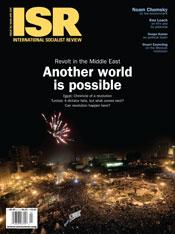The characters of early anarchism

The World That Never Was:
ALEX BUTTERWORTH’S new book, The World That Never Was, chronicles the rise of anarchism in Europe and the United States during the late 19th and early 20th centuries. Butterworth introduces readers to a fascinating array of scientists, activists, freethinkers, revolutionaries, and double agents in an epic narrative spanning from the Paris Commune to the Russian Revolution.
The World That Never Was brilliantly contextualizes the political radicalism of the time with discussions of scientific advancements, architectural achievements, and artistic endeavors that characterized the turn of the century: the Eiffel Tower, modern geography, aeroballoons, the new science fiction literature, and especially dynamite. For Butterworth, the anarchists of the period best represented the complex intellectual advancements of science as well as the utopian idealism of the era with all of the inherent contradictions.
Early in the book, we meet Élisée Reclus, the world-famous French geographer and anarchist whose travel writings documented how a displaced Choctaw tribe in the United States sent a large donation to starving people in Ireland—an act of solidarity inspired by with their own experiences on the Trail of Tears. Historical gems such as this pepper the entire book and give the reader a genuine sense of the depth and history of the radical tradition.
Butterworth’s discussion of the Paris Commune highlights the work of Louise Michel, the French anarchist and feminist who played such an important role in the defense of the Commune. When discussing these early anarchists, Butterworth’s writing beautifully captures the optimism of the book’s heroes, the dreamers like Reclus and Michel who fought for a different kind of world. His writing is much less coherent, however, in discussing the real contradictions between the anarchists and other radicals, or among the anarchists themselves.
Unsurprisingly, The World That Never Was is overtly hostile to Marxism and Leninism throughout its pages. Butterworth depicts both Karl Marx and Frederick Engels as specialists in political maneuver, rehashing the trite misrepresentation of their debates with Mikhail Bakunin in the First International: “Bakunin’s doctrine of federalism and grassroots activism on one side, Marx’s vision of a centralized authority guiding the workers towards the coming revolution on the other.” This type of calumny pollutes the rest of the book with allusions to Marx’s “bullying and overbearing branch of Teutonic socialism,” his “centralizing and dogmatic” projects, and so on.
The author has a similar distaste for Lenin, writing, “Lenin concluded that, having bided its time, a revolutionary elite must seize power and implement a centralized revolutionary program.” But most confusingly, Butterworth admits that the Bolsheviks maintained the only serious program for socialism and peace in Russia. And because of this, “significant numbers of anarchists continued to lend Lenin their support, viewing recent events as a vindication of their belief in revolution by mass action.” These discrepancies are never drawn out or developed, resulting in clumsy formulations of actual political debates and their ramifications.
If Butterworth fails to understand the innovations of Marx or Lenin, he further misunderstands his own anarchist protagonists, and his analysis falls flat. While he positions the Russian anarchist Peter Kropotkin in the company of “dreamers” (after supposedly rejecting his aristocratic background for the life of an anarchist), Butterworth remains ambivalent over Kropotkin’s fondness for the British Empire or his support for the Allied powers in the World War. The book simply offers no contrast or analysis of Lenin’s anti-imperialism or Kropotkin’s support for the provisional Kerensky government.
The discussions of “propaganda by the deed” in the American context are also unsatisfying. Rather than a frank discussion of effective strategies for revolution, Butterworth only deals with intrigue and conspiracy. Alexander Berkman’s attempted murder of Henry Clay Frick, chairman of Carnegie Steel, during the Homestead Strike contains no discussion regarding the very negative effects of its backlash on the strikers themselves. Worse, Butterworth goes out of his way to characterize Berkman’s actions as an attempt to impress Emma Goldman in competition with Johann Most, author of the booklet, The Science of Revolutionary Warfare.
These “schemers” like Berkman receive kid-glove treatment from Butterworth, who fails to grasp the tragic consequences of their actions. Rather than acknowledge the bankruptcy of these anarchist schemes and their ideological roots, Butterworth depicts the anarchists as naïve, idealistic, and motivated by the desire to create radical change. However these types of violent actions might be out of sync with the traditions of mass action like the Paris Commune is inconsequential—Butterworth still places these characters under the rubric of anarchist dreamers.
Intermittent chapters throughout the book deal with the secret police agents of the Okhrana (Russian Secret Police) and similar organizations; how they lived double lives as anarchists, infiltrated organizations, and routinely provoked violence in order to cripple the revolutionary movements. The ease with which agents moved in and out of anarchist groups prompted even Kropotkin to complain, “Now the revolution has become a sport: ‘If they arrest me, I will go over to their side!’”
The World That Never Was does an eloquent job of dishing the dirt on the characters of early anarchism. Butterworth’s story reads like a smutty adventure novel replete with revolutionaries, sexual intrigue, and provocateurs. Ultimately, the book’s treatment of revolutionary politics is woefully undeveloped, leaving the reader entertained—but likely confused by a mish-mash of conspiracy theory and idealism.


 Facebook
Facebook Twitter
Twitter Google+
Google+ Tumblr
Tumblr Digg
Digg Reddit
Reddit StumbleUpon
StumbleUpon
